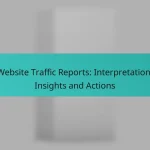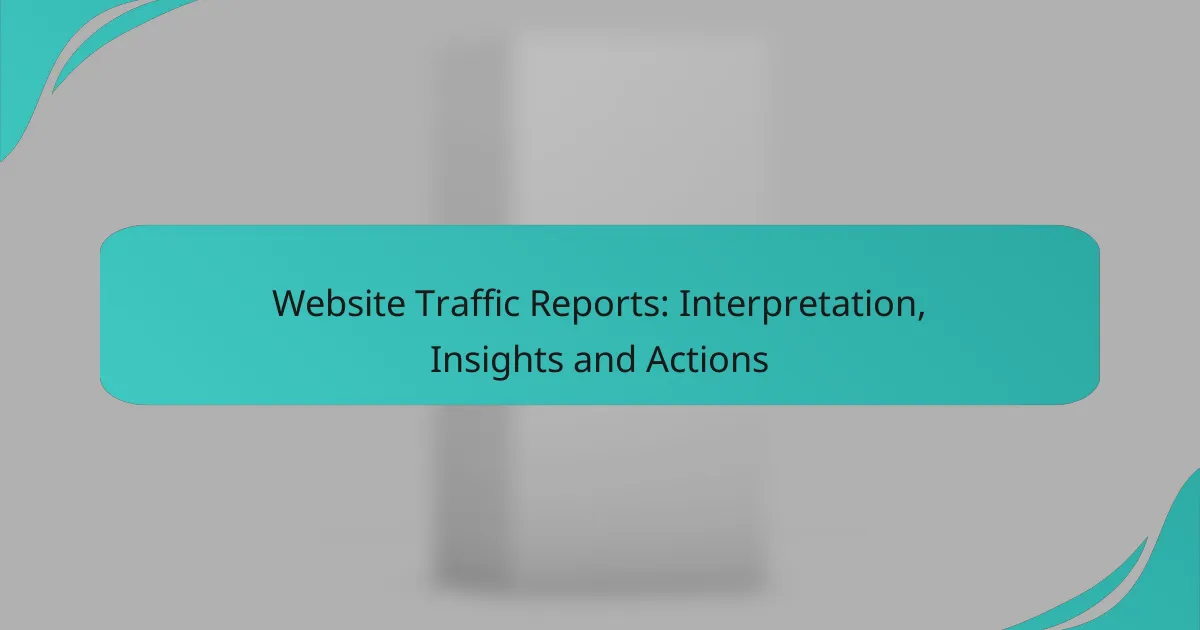Website traffic reports are essential tools for understanding user behavior and engagement. By analyzing key metrics, businesses can uncover valuable insights that reveal trends, strengths, and weaknesses in their online presence. This information enables informed decision-making to optimize content, enhance user experience, and ultimately drive conversions.

How to interpret website traffic reports in the UK?
Interpreting website traffic reports in the UK involves analyzing key metrics that indicate user behavior and engagement. Understanding these metrics helps identify trends, optimize content, and improve overall website performance.
Key metrics to analyze
When analyzing website traffic reports, focus on metrics such as unique visitors, page views, bounce rate, and average session duration. Unique visitors indicate the number of distinct individuals visiting your site, while page views show how often pages are accessed.
Bounce rate is crucial as it reflects the percentage of visitors who leave after viewing only one page, suggesting potential issues with content relevance or user experience. Average session duration provides insight into how long users engage with your site, helping to gauge content effectiveness.
Common trends in UK traffic
In the UK, common trends include increased mobile traffic and a growing emphasis on local SEO. Many users now access websites via smartphones, making mobile optimization essential for retaining visitors. This shift requires ensuring that your site is responsive and loads quickly on mobile devices.
Another trend is the rise of local searches, with users often looking for services or products in their vicinity. Incorporating local keywords and optimizing for Google My Business can enhance visibility and attract more relevant traffic.

What insights can be gained from traffic reports?
Traffic reports provide valuable insights into how users interact with a website, revealing patterns in behavior, conversion rates, and overall engagement. By analyzing these reports, businesses can identify strengths and weaknesses in their online presence and make informed decisions to enhance user experience and drive conversions.
User behavior patterns
User behavior patterns reflect how visitors navigate a website, including the pages they visit, the time spent on each page, and their exit points. Understanding these patterns helps identify which content resonates with users and which areas may need improvement. For example, if a significant number of users leave after viewing a specific page, it may indicate that the content is not engaging or relevant.
To analyze user behavior effectively, consider using tools like heatmaps or session recordings. These tools can visually represent user interactions, highlighting areas of interest and confusion. Regularly reviewing this data can help refine content strategy and improve site navigation.
Conversion rate analysis
Conversion rate analysis measures the percentage of visitors who complete a desired action, such as making a purchase or signing up for a newsletter. This metric is crucial as it directly impacts revenue and business growth. A low conversion rate may suggest issues with the website’s design, messaging, or user journey.
To enhance conversion rates, test different elements on your site, such as call-to-action buttons, landing page layouts, and overall user experience. A/B testing can be particularly effective in determining which variations lead to higher conversions. Additionally, ensure that your website is optimized for mobile users, as a significant portion of traffic often comes from mobile devices.

What actions should be taken based on traffic data?
To effectively leverage traffic data, businesses should analyze trends and user behavior to make informed decisions. This involves adjusting strategies based on insights gained from traffic patterns, which can lead to improved engagement and conversions.
Optimizing content strategy
Optimizing your content strategy requires a thorough analysis of which pages attract the most visitors and which content keeps them engaged. Focus on high-performing topics and consider updating or expanding underperforming content to better meet user needs.
Utilize tools like Google Analytics to identify keywords driving traffic and tailor your content to align with these search terms. Regularly review and adjust your content calendar based on traffic trends to ensure relevance and freshness.
Improving user experience
Improving user experience is crucial for retaining visitors and reducing bounce rates. Analyze metrics such as page load times and navigation paths to identify areas that may frustrate users. Aim for load times under three seconds and intuitive navigation structures.
Implement user feedback mechanisms, such as surveys or usability tests, to gather insights directly from visitors. Small changes, like simplifying forms or enhancing mobile responsiveness, can significantly enhance overall user satisfaction and engagement.

How to set up website traffic reporting tools?
Setting up website traffic reporting tools involves selecting the right software and configuring it to track relevant metrics. Key steps include creating an account, adding tracking codes to your site, and defining goals to measure performance effectively.
Google Analytics setup
To set up Google Analytics, first create a Google Analytics account and set up a property for your website. You will receive a tracking ID that needs to be added to your website’s code, typically in the header section. This allows Google Analytics to collect data on user interactions.
Once the tracking code is implemented, configure goals to measure specific actions, such as form submissions or purchases. Regularly review the reports to analyze traffic sources, user behavior, and conversion rates, which can guide your marketing strategies.
Using SEMrush for insights
SEMrush is a powerful tool for gaining insights into website traffic and competitor performance. Start by entering your website URL to access a comprehensive overview of traffic trends, sources, and user demographics. This can help identify strengths and weaknesses in your online presence.
Utilize SEMrush’s keyword analytics to discover which search terms drive traffic to your site. By comparing this data with competitors, you can refine your SEO strategy and target high-potential keywords. Regularly check the site audit feature to ensure your website is optimized for search engines and user experience.

What are the prerequisites for effective traffic analysis?
Effective traffic analysis requires a clear understanding of your audience and well-defined business goals. These prerequisites ensure that the insights gained from traffic reports are relevant and actionable for your specific context.
Understanding audience demographics
Audience demographics provide critical insights into who is visiting your website. Key factors include age, gender, location, and interests, which can influence content and marketing strategies. For instance, if a significant portion of your traffic comes from a specific age group, tailoring your messaging to resonate with that demographic can enhance engagement.
Utilizing tools like Google Analytics can help you gather demographic data. Regularly reviewing this information allows you to adapt your approach based on shifts in audience composition, ensuring your content remains relevant and appealing.
Defining business goals
Clearly defined business goals are essential for effective traffic analysis. These goals should align with your overall strategy, whether it’s increasing sales, generating leads, or enhancing brand awareness. For example, if your goal is to boost online sales, analyzing traffic sources that lead to conversions becomes crucial.
Establishing specific, measurable objectives allows you to track progress and adjust your tactics accordingly. Consider using the SMART criteria—Specific, Measurable, Achievable, Relevant, Time-bound—to formulate your goals. This structured approach helps ensure that your traffic analysis efforts contribute directly to your business outcomes.

What are common pitfalls in traffic report interpretation?
Common pitfalls in traffic report interpretation include overlooking critical data trends and misinterpreting user behavior. These mistakes can lead to misguided strategies and ineffective marketing efforts.
Overlooking seasonal trends
Seasonal trends significantly impact website traffic, and failing to account for them can skew your analysis. For instance, e-commerce sites often see spikes during holidays or special events, while other industries may experience dips during summer vacations.
To avoid this pitfall, compare traffic data year-over-year during the same periods. This approach helps identify patterns and allows for better forecasting and planning.
Ignoring mobile traffic data
With increasing numbers of users accessing websites via mobile devices, ignoring mobile traffic data can lead to incomplete insights. If your reports focus solely on desktop traffic, you may miss out on understanding a significant portion of your audience.
Make it a priority to analyze mobile traffic separately. Look for trends in user engagement, bounce rates, and conversion rates on mobile versus desktop. This data can inform design and functionality improvements tailored to mobile users.

How to leverage traffic reports for lead generation?
Traffic reports are essential tools for enhancing lead generation by providing insights into visitor behavior and preferences. By analyzing these reports, businesses can identify high-performing content, optimize marketing strategies, and target potential customers more effectively.
Understanding visitor behavior
To leverage traffic reports for lead generation, first, understand visitor behavior. Analyze metrics such as page views, time spent on site, and bounce rates to gauge how users interact with your content. This data helps identify which pages attract and retain visitors, indicating potential interest areas.
For example, if a blog post on a specific topic receives significantly more traffic than others, it suggests that your audience is interested in that subject. Focus on creating more content around similar themes to capture leads effectively.
Identifying high-converting pages
Next, identify high-converting pages through traffic reports. Look for pages with high conversion rates, such as landing pages or product descriptions that lead to sign-ups or purchases. Understanding which elements contribute to these conversions can help replicate success across other pages.
Consider A/B testing different headlines, calls to action, or layouts on these high-performing pages to further optimize lead generation. Small changes can lead to significant improvements in conversion rates.
Segmenting your audience
Segmenting your audience based on traffic report data allows for more targeted marketing efforts. Use demographic information, referral sources, and user behavior to create distinct audience segments. Tailor your messaging and offers to meet the specific needs of each group.
For instance, if traffic reports reveal that a significant portion of your visitors comes from social media, consider developing targeted campaigns for that audience. This approach increases the likelihood of converting visitors into leads.
Optimizing content for SEO
Traffic reports can also guide SEO optimization efforts. Analyze which keywords drive the most traffic to your site and ensure your content aligns with these search terms. Optimizing for relevant keywords can improve visibility and attract more qualified leads.
Regularly update and refresh content based on traffic trends to maintain relevance. This practice not only helps with SEO but also keeps your audience engaged, increasing the chances of lead conversion.
Using analytics tools
Utilize analytics tools to enhance your understanding of traffic reports. Platforms like Google Analytics provide in-depth insights into user behavior, traffic sources, and conversion tracking. Familiarize yourself with these tools to make data-driven decisions that support lead generation efforts.
Set up goals and funnels within these analytics tools to track user journeys from initial visit to conversion. This tracking helps identify drop-off points and areas for improvement in your lead generation strategy.







